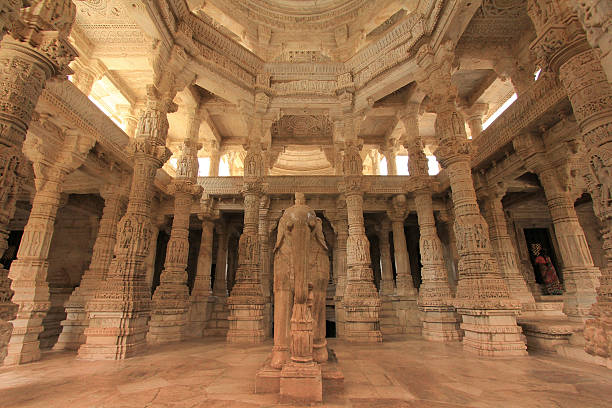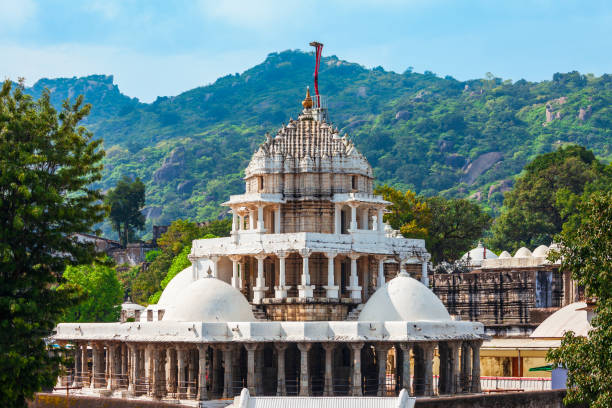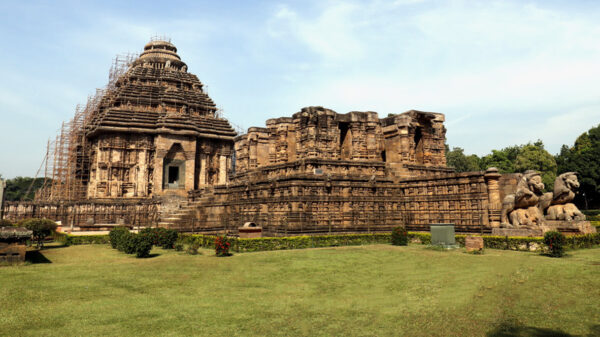There are several places on our planet that can leave you speechless at first sight. The breathtaking and exquisite beauty offered by some destinations is truly commendable, as I’ll discuss in my blog. Today, I will delve into the famous Jain Temple, a magnet for hundreds of tourists. Not only is it a renowned pilgrimage spot, but the Dilwara Temple is also an architectural marvel that should definitely be on your bucket list
The Dilwara Group of Temples forms an expansive temple complex comprising five exquisitely sculpted shrines, each dedicated to Jain Tirthankaras – Lord Adinath, Lord Rishabhdeo, Lord Neminath, Lord Mahavir Swami, and Lord Parshvanath. Constructed between the 11th and 13th centuries, these temples have long been revered by Jain pilgrims, drawing them annually to offer fervent prayers.
What truly distinguishes these temples is their extraordinary architecture, captivating all who visit. The intricate detailing of the temples and pillars is so remarkable that it often leaves observers pondering whether the architects possessed magical abilities.
The sheer splendour of these temples has a mesmerising effect, causing many to enter a kind of trance, gazing at them for hours in sheer admiration.
the temple complex boasts remarkable architecture renowned for its symmetry, with each of the five temples designed symmetrically yet surrounded by passages rather than forming a public square.
The intricately carved pillars within each shrine captivate observers, drawing prolonged admiration. Carvings embellish every hall, wall, and ceiling, adding to the temples’ majestic appearance.
Despite their intricate carvings, the temples exude simplicity, aligning with the Jaina philosophy that advocates simplicity in lifestyle and ideology.
These temples are credited with pioneering interior design concepts, inspiring architects to prioritise interior spaces alongside exteriors, marking a significant shift in architectural focus.
Vimal Vasahi Temple
This is the first temple out of the first and it is the abode of Lord Adinath. He was the first Jain Tirthankar and is highly revered among his followers. The temple is actually named after the Maharaja of Gujarat, who in 1021 built this wonderful shrine.
As I reached the temple I was blown away by the creativity behind the architecture. The temple is actually built in a huge wide open square and is completely encircled by a lovely passageway.
As I walked through the passage I noticed the way it has been carved by us so detailed and beautiful. This shrine is decorated with such carved passageways, columns, doorways and epic arches, that give the temple all that it commands.Another defining factor in this temple is the gorgeous Rang Mandap- which is essentially a massive hall with amazingly ornate pillars. The room is further beautified by the arches that are strategically placed in the middle of an even for the resplendent dome.
Another defining factor in this temple is the gorgeous Rang Mandap- which is essentially a massive hall with amazingly ornate pillars. The room is further beautified by the arches that are strategically placed in the middle of an even for the resplendent dome
The main hall is the one that has the deity, and one can offer their prayers there.
Luna Vasahi Temple

As I left the gorgeous shrine, I was met with some Jaina monks who were making their way to the next time like me. It was a sight to behold. Men with bowed heads just making their way together as the massive temples became the perfect background.
I followed them and was soon in front of the second most important shrine called the Luna Vasahi Temple..
This was built in 1230 and is devoted to Lord Neminath.
As I reached the main hall, the first thing that totally made me speechless was the exquisitely carved central from that house 72 figures of Tirthankars. The white marble work here left me talking about it for ages. I looked at the intricately carved figures and realised how life like these marble figures are. It was almost as if they would jump out and come alive. The main hall hosts the deity which is wonderfully carved out of a marvellously shining back marble. As I turned on my left to leave, I was majestically greeted by a magnificent black pillar which goes by the name of Kirti Stambh.
Pittalhar Temple
This lovely little shrine was my next stop. This shrine is dedicated to Lord Rishabdeo, and the temple also has a massive picture of the Lord.
As I came face to face with this image I was pleasantly surprised to see that it was made with five metals, in which brass was the dominating one. This unique idea gives the temple its name- Pittalhar.
This temple too has all the traditional concepts of Jaina architecture including- the main hall, Navchowki, and Garbhagraha.
The Parshvanatha Temple, constructed in 1459 and rising uniquely with three stories, exclusively honours Lord Parshvanatha. Its towering stature, unrivalled in Dilwara, contributes to its distinct charm.
Inside, the ground floor unveils four grand halls adorned with intricately carved walls, while the exterior boasts breathtaking grey sandstone sculptures, emanating a different positive energy.
Exploring this temple invoked an overwhelming sense of devotion and tranquillity, transcending mere admiration for its architectural splendour. It evoked a profound feeling of being at home, a spiritual connection miles away from my actual home.
Bowing alongside fellow devotees before the idol of Lord Parshvanatha left me filled with a deep sense of contentment and fulfilment, satiating the traveller within me.
As for the Mahavir Swami Temple, dedicated to the revered Tirthankara Lord Mahavira, its humble small structure reflects the simplicity embraced by Lord Mahavira and his followers, devoid of materialistic pleasure.
How to reach?
Dilwara Temples in Mount Abu, Rajasthan, are accessible by road. You can reach Mount Abu by bus, car, or taxi from nearby cities like Udaipur, Ahmedabad, or Abu Road railway station. From Mount Abu town, the temples are a short drive away and can be reached by local transport or taxi.
Where to stay?
Mount Abu offers various accommodation options ranging from budget hotels to luxury resorts. Some popular areas to stay include the town centre, near Nakki Lake, or along the main road leading to the town. It depends on your preferences and budget. There are heritage hotels, guesthouses, and resorts catering to different needs. Booking in advance, especially during peak seasons, is advisable
Some special tips
The temple holds its own magnificence and is governed by specific rules and regulations that deserve utmost respect.
Photography is strictly prohibited within the temple premises, so it’s essential to adhere to this guideline.
Additionally, consider exploring other destinations like Mount Abu during your visit
Final thoughts
Many visitors head to Mount Abu to relish its picturesque hilly landscapes, but merely 2.5 km away lies the magnificent Jain Temple. These temples boast intricate designs that envelop you in a magical aura the moment you step inside. The serenity and tranquillity permeate through your senses. While the temple holds significance for pilgrims, it’s also a captivating destination that you should experience at least once in your lifetime











